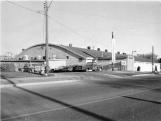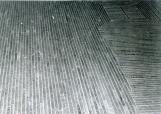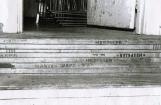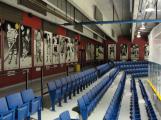1
The original place to play hockey in early Kirkland Lake was the lake itself. By the end of December, a solid ice surface could be found on the lake, and games of shinny or "pond hockey" were easy enough to organize with makeshift goal posts and pucks. Team size would sometimes depend on how many people showed up to play, and games could go on until it was too dark to play. The ice surface would usually last until March, and then the wait would be on until the next hockey season.As the years went by and the town grew, so did the mines and their production. The lake the town was named after was gradually being filled in with waste rock material from the mines. The use of the lake as a hockey rink declined, and manmade outdoor rinks became common, and could be found on school property, in backyards, and even on ice-covered roads. All ages and skill levels participated in hockey, and both men's and women's teams competed in the area. The rinks were simply maintained with the use of shovels to remove excess snow, and keeping the rinks in good condition was a community effort. The sides of the rink could have planks of board surrounding it, or just snowbanks. Small huts where people could change into their skates or warm up were sometimes available.
Despite their best efforts to preserve the rink, the skating season was still limited to the length of the winter season.
2
Arenas were used as community centres and multi-purpose facilities. In addition to skating and hockey during the winter months, the lack of artificial ice meant that the ice surface only lasted as long as the cool temperatures did. For the rest of the year, the rink area was left bare for different events, such as fall fairs, large banquets, and even visiting circuses.3
Outside of Kirkland Lake ArenaCirca 1978
Lakeshore Arena/Kirkland Arena, Kirkland Lake, Ontario, Canada
 Credits:
Credits:Photograph donated by Richard Buell
Hockey Heritage North Archives
4
The first indoor arena in Kirkland Lake was built in 1926, and opened to the public on January 12, 1927. The Kirkland Lake Community Arena was also less formally known as the Lakeshore Arena. The need for an indoor arena was seen by many people in town as a proper venue to watch hockey tournaments and stay out of the -30 degree temperatures. It was Harry Oakes, owner of the Lake Shore Mine and prominent Kirkland Lake citizen who provided the land and some of the equipment in-kind to the community so the arena could be built.5
Interior View of Kirkland Lake ArenaCirca 1978
Lakeshore Arena/Kirkland Arena, Kirkland Lake, Ontario, Canada
 Credits:
Credits:Photograph donated by Richard Buell
Hockey Heritage North Archives
6
Jim Watson - Sneaking Into the Kirkland Lake Arena16 January 2010
Hockey Heritage North, Kirkland Lake, Ontario, Canada
 Credits:
Credits:Jim Watson Interview
Hockey Heritage North Archives
7
The Kirkland Lake Arena changed little over the decades, but it did develop character. The wooden seating for the fans stayed intact, and the lighting was improved over the ice surface. Hockey tournaments and hockey rivalries like the Rouyn-Noranda vs. Kirkland Lake games were played out in the arena. With limitations on ice time, the indoor arena was used by Midget, Juvenile and Senior hockey teams. Other levels of hockey continued to be played on the outdoor rinks.8
Bill Plager - Outdoor Rinks and In The Arena5 September 2009
Hockey Heritage North, Kirkland Lake, Ontario, Canada
 Credits:
Credits:Bill Plager Interview
Hockey Heritage North Archives
9
But like many older buildings, repairs increased and so did the costs of maintaining the Kirkland Community Arena. The Joe Mavrinac Community Complex was built to replace the old Arena, and was constructed with more modern facilities at the east end of Kirkland Lake. The old Arena was slated for demolition.10
Kirkland Lake Arena FloorboardsCirca 1978
Lakeshore Arena/Kirkland Arena, Kirkland Lake, Ontario, Canada
 Credits:
Credits:Photograph on loan from Ted Irvine
11
Kirkland Lake Arena FloorboardsCirca 1978
Lakeshore Arena/Kirkland Arena, Kirkland Lake, Ontario, Canada
 Credits:
Credits:Photograph loaned by Ted Irvine
12
Kirkland Lake Arena FloorboardsCirca 1978
Lakeshore Arena/Kirkland Arena, Kirkland Lake, Ontario, Canada
 Credits:
Credits:Photograph on loan from Ted Irvine
13
Continuing in the tradition of the early arenas, the Joe Mavrinac Community Complex offers an ice surface for most of the year for the hockey players and figure skaters, and in the summer months the ice surface is removed to make room for other events, such as trade shows and concerts. In addition to an arena, the Joe also has squash courts, exercise rooms and a swimming pool - making it a truly multi-purpose facility in the community.The arena remains the focal point, though. The larger than life paintings that surround the walls of the arena are of the 42 hockey players who have a connection with Kirkland Lake and went on to play in the National Hockey League. These paintings were created by Kirkland Lake artist Mark Didine.
The paintings also represent a connection between Kirkland Lake's hockey past with its players and the old Kirkland Arena, to the current arena that is home to the next generation of hockey stars.
14
Joe Mavrinac Community Complex Wall PaintingsCirca 2005
Joe Mavrinac Community Complex, Kirkland Lake, Ontario, Canada
 Credits:
Credits:Joe Mavrinac Community Complex
Original artwork by Mark Didine